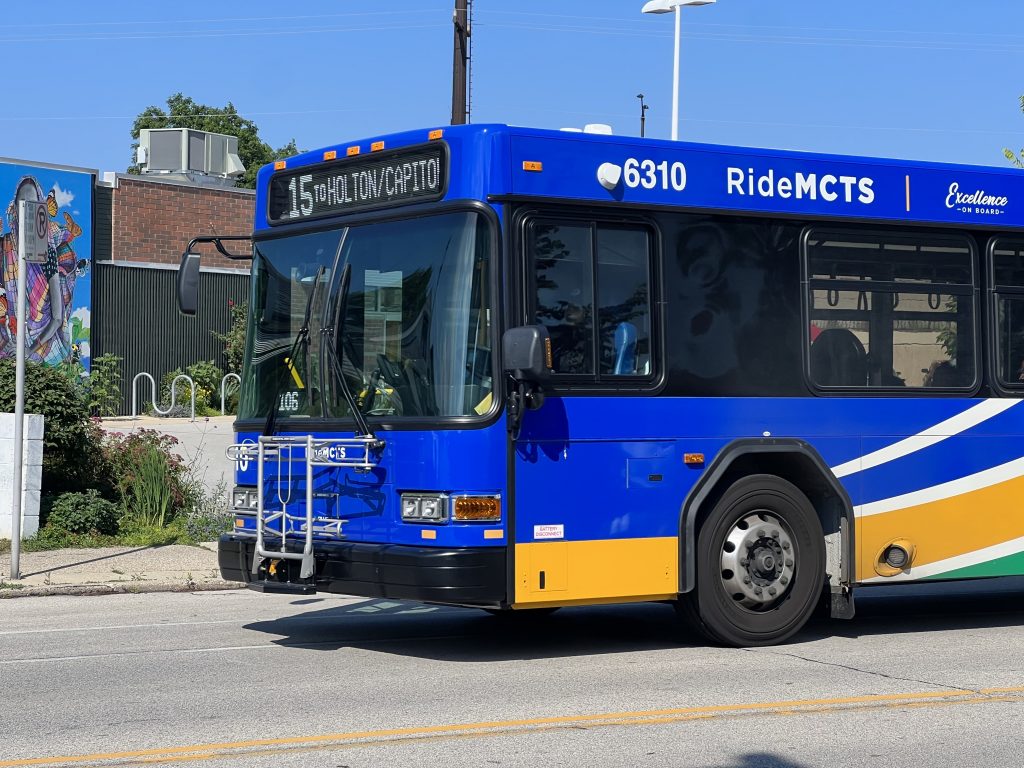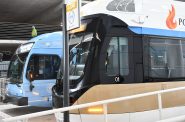MCTS Announces Service Cuts
Budget shortfall forcing it to reduce bus frequency along some high frequency routes.

MCTS bus. Photo by Jeramey Jannene.
The Milwaukee County Transit System (MCTS) will cut bus frequency in August in an effort to close a projected $10.9 million budget gap.
The transit system announced that low passenger revenue and “unexpected expenses” have left the system with a projected budget gap by the end of the year. Buses will arrive more infrequently along a number of “non-peak weekday high-frequency routes with the lowest ridership mid-day, and frequency levels on Saturdays” amounting to a 20,000-hour cut to bus service.
MCTS did not name the “unexpected expenses” in a statement released Tuesday. The system said it would announce which routes are facing frequency cuts at a later date and that it “plans to give riders as much advance notice as possible.”
“Reducing the frequency of buses is the last thing we want to do but it will have the least impact on our riders,” said Julie Esch, MCTS Interim Managing Director.
In 2021, MCTS finished a major route overhaul called MCTS Next that rebalanced the system in favor of more high-frequency bus routes. In May, planners finalized a smaller series of route changes, called MOVE 2025, which are planned to take effect in the fall. Those will still be going forward, according to the statement.
MCTS has long had a structural deficit, with the system costing more to operate than it collects in revenue. In recent years, the budget gaps were plugged with federal stimulus funds released during the COVID-19 pandemic. The temporary fix left budget deficits looming in the future over the past five years, and despite efforts to forestall the inevitable, they have returned much sooner than anticipated.
Last year, the system cancelled plans to continue developing a much anticipated second bus rapid transit line. The nine-mile route would have run north and south along the 27th Street Corridor. Shelving the project was supposed to save the transit budget until at least 2028.
The system has been reducing service hours and cutting routes for more than a decade. In recent years, the Freeway Flyers and special event shuttles disappeared. In 2025, the system implemented a modest fare increase.
Before the COVID-19 pandemic, MCTS narrowly avoided a 10% cut to bus routes when faced with an approximately $8 million budget deficit. It was considered a temporary fix, with cuts expected in future years. Then it received a windfall of pandemic stimulus funding and those decisions were further put off.
But the underlying revenue structure has remained the same, and without long-term, sustainable funding or a massive jump in fare revenue, the cuts will continue.
Update
Following publication, A spokesperson for MCTS told Urban Milwaukee the system expected it would reduce service along 10 high-frequency routes on weekdays, during hours when ridership is low. Bus frequency on Saturdays would be reduced “across several routes” to mirror service levels on Sundays.
All-day high frequency service would be maintained on Connect 1, 30, PurpleLine, Redline, BlueLine, and 35. According to MCTS route map, that leaves Routes 12, 15, 18, 19, 21, 51, 60, 66, 76, 80 and the GreenLine available for potential service reductions.
If you think stories like this are important, become a member of Urban Milwaukee and help support real, independent journalism. Plus you get some cool added benefits.
More about the 2025 MCTS Financial Issues
- FTA Tells Milwaukee to Crack Down on Fare Evasion — Even Where Fares Don’t Exist - Graham Kilmer - Dec 12th, 2025
- Transportation: County Names New Director of Transportation - Graham Kilmer - Dec 5th, 2025
- Transportation: MCTS Budget Picture Keeps Getting Worse - Graham Kilmer - Dec 4th, 2025
- Transportation: MCTS Avoids Full Route Cuts Under New Plan - Graham Kilmer - Nov 27th, 2025
- Transportation: Supervisor Pushes Fare Evasion Plan, Tangles With Sheriff - Graham Kilmer - Oct 23rd, 2025
- Transportation: Bus Cuts Leave Some Riders Stranded - Graham Kilmer - Oct 21st, 2025
- Transportation: Emails Reveal MCTS Officials Concealed Budget Deficit From Comptroller, County Board - Graham Kilmer - Oct 10th, 2025
- Transportation: 6 Bus Routes That Could Disappear in 2026 - Graham Kilmer - Sep 30th, 2025
- Transportation: MCTS Reaches New Labor Agreement With Union - Graham Kilmer - Sep 27th, 2025
- Transportation: Rep. Steil Calls For Greater Federal Oversight of MCTS - Graham Kilmer - Sep 17th, 2025
Read more about 2025 MCTS Financial Issues here
MKE County
-
Fellow Judge Testifies in Dugan Case
 Dec 16th, 2025 by Graham Kilmer
Dec 16th, 2025 by Graham Kilmer
-
Key Questions in Dugan Trial Take Shape on First Day
 Dec 15th, 2025 by Graham Kilmer
Dec 15th, 2025 by Graham Kilmer
-
FTA Tells Milwaukee to Crack Down on Fare Evasion — Even Where Fares Don’t Exist
 Dec 12th, 2025 by Graham Kilmer
Dec 12th, 2025 by Graham Kilmer
Transportation
-
Congestion Pricing Cuts Air Pollution in New York City
 Dec 14th, 2025 by Jeff Wood
Dec 14th, 2025 by Jeff Wood
-
FTA Tells Milwaukee to Crack Down on Fare Evasion — Even Where Fares Don’t Exist
 Dec 12th, 2025 by Graham Kilmer
Dec 12th, 2025 by Graham Kilmer
-
Will GOGO’s Bus Service Ever Get Going?
 Dec 9th, 2025 by Jeramey Jannene
Dec 9th, 2025 by Jeramey Jannene





















Perhaps the low passenger revenue is due in part to those disrespectful folks who feel they are entitled, for whatever reason, to ride for free, and the operators refusing to do anything about it. Call the office and have security come and escort the freeloaders off. It is really discouraging to those who play by the rules to see this happen on an almost daily basis, and sometimes, several times a day. MCTS sure isn’t what it once was. However, I am thankful I still have the option of taking MCTS, even though its service is rapidly declining.
It needs more users, and not just those that have no other transportation choice. Right now, the bus is usually the least efficient option to get around by a significant margin. This isn’t always true in other cities. The MCTS has too many stops on routes I’m familiar with, resulting in very long travel times (and the need for more buses and drivers and maintenance (i.e. costs). In some other cities, stops might be every 1/2 mile. They seem to be every 500ft on some routes, and during the popular times, end up stopping at nearly all of them. A no transfer 7 mile journey shouldn’t have to take 48 minutes, when you can ride your bike in 30 and drive in 14. Humans with enough economic mobility as a group will always choose the most efficient method.
The article slightly confuses “structural deficit” with “farebox recovery ratio” in this sentence:
“MCTS has long had a structural deficit, with the system costing more to operate than it collects in revenue”
Farebox recovery ratio is rarely, if ever, 100% anywhere in the world. Structural deficit is not just about fare collection, it is about all income: federal, state, and county funding – as well as fares.